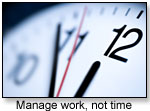 |

Tools:








Stop Managing Time, and Start Managing YourselfKeep Your Agreements and Time Is Will Be on Your Side
This article was reprinted with permission from the author.
 You can’t manage time. Time just is. You don’t mismanage five minutes and wind up with four, or six. So what is this thing that has been mislabeled for so many years, and why did it get an inappropriate name? Time management is really managing what we do, during time. But it’s easier for executives to say that time is what needs to be managed, rather than themselves. It’s easier to make time the enemy and parade our worthiness (I have so many big, important things to get done), rather than to say “I don’t keep my agreements.” You can’t manage time. Time just is. You don’t mismanage five minutes and wind up with four, or six. So what is this thing that has been mislabeled for so many years, and why did it get an inappropriate name? Time management is really managing what we do, during time. But it’s easier for executives to say that time is what needs to be managed, rather than themselves. It’s easier to make time the enemy and parade our worthiness (I have so many big, important things to get done), rather than to say “I don’t keep my agreements.”
Do What You Said You'd Do
Time management is really agreement management. At the end of the day, how good you feel about what you did (and what you didn’t do) is proportional to how well you think you kept agreements with yourself. Did you do what you told yourself to do? Did you accomplish what you think should have been accomplished? Wasting time only means that you think you should have been doing something other than what you were doing. Sleep is not a waste of time if you think you need it. Taking a walk instead of rewriting your strategic plan is not a waste of time as long as you think taking a walk is the thing to do at that moment. It’s when you wind up not having done that which you’ve agreed with yourself should be done that the trouble begins.
A trait of sophisticated executive leadership is the ability to take risks. Because a healthy sense of self is required to take those risks, as you graduate in levels of responsibility it becomes increasingly important that you trust yourself. One of the greatest saboteurs of that self-trust is broken agreements. Obviously if those agreements are not kept with others – staff, customers, stakeholders – the ability to garner their support is automatically diminished. But the real victim of commitments unfulfilled is you. Nothing takes the wind out of your sails more than not keeping your agreements with yourself.
Most executives probably consider themselves relatively trustworthy. But commitment management is way more complex, subtle, and challenging than most people realize. In order to really be in the clear, you must first know what all your agreements are – and there are very few people who have them all defined and contained.
Live Your Values
The most basic agreement is to show up at a designated location at a specific time (appointment). The most subtle and sophisticated agreement is to be doing what you think you should be doing with your life (are you fulfilling your purpose, living according to your values?) And there are all kinds of agreements lying in-between.
 Most executives have between 40 and 100 projects, a “project” being defined as something they want to finish that requires more than one action step (get a new car, hire an assistant, take the family skiing, launch the new product line, restructure their board, get a new set of golf clubs, etc.) Those projects are driven by ten to fifteen key areas of responsibility in their job (strategic planning, asset management, staff development, liaison with the board, etc.) and in their life (health, relationships, career, money, etc.) Add to that the responsibility of defining and communicating the vision of the company and formulating and executing both the long- and short-term strategies to get there. Moreover you can’t really do any of those things – they represent outcomes and final results. The next needed physical actions (allocation of personal resources) required to execute on all of those commitments – emails to send, phone calls to make, conversations to have, documents to draft, proposals to read – number often in the hundreds. Most executives have between 40 and 100 projects, a “project” being defined as something they want to finish that requires more than one action step (get a new car, hire an assistant, take the family skiing, launch the new product line, restructure their board, get a new set of golf clubs, etc.) Those projects are driven by ten to fifteen key areas of responsibility in their job (strategic planning, asset management, staff development, liaison with the board, etc.) and in their life (health, relationships, career, money, etc.) Add to that the responsibility of defining and communicating the vision of the company and formulating and executing both the long- and short-term strategies to get there. Moreover you can’t really do any of those things – they represent outcomes and final results. The next needed physical actions (allocation of personal resources) required to execute on all of those commitments – emails to send, phone calls to make, conversations to have, documents to draft, proposals to read – number often in the hundreds.
All of these agreements must be incorporated into the commonly touted best practice of “setting priorities.” And if any one of those multiple horizons of “work” has not been adequately captured, clarified, organized and reviewed, there will be to some degree a lack of trust in your own behavior.
Systematize
Because this huge self-management challenge was obscured and oversimplified with the concept of “time management,” the training, methods and tools for dealing with it have been woefully inadequate. If time were the only beast to be tamed, a clock and a diary (and some efficiency) were all you really needed. Handling commitments was relegated to a simple little best practice – have a daily to-do list. But that hasn’t really worked since the telephone, and to reduce the management of the complexity of the world within which we operate at multiple levels of focus and responsibility down to a simple “ABC” categorization of a simple list for the day creates more frustration than freedom.
The real best practices of self-management for high-performing professionals now need to include a thorough capturing and clarifying of all commitments – little, big, personal and professional – into a seamless system. And in addition to the obvious high-level outcomes that must be defined and reviewed (purpose, values, vision, goals, strategies) there must be an equal rigor with deciding and tracking the much larger number of projects and actions required to get things done – all with appropriate boundaries to ensure a sustainable balance in life and work. The degree to which you feel good about what you’re doing is equal to the degree that you know what you’re not doing, and have made that OK. That’s enough of an executive challenge. It’s time to put time management behind us.
For more David Allen Company tools and educational content, check out our GTD Products section at davidco.com. For our online learning center, visit GTD Connect at gtdconnect.com.
 Writer's Bio: Writer's Bio: David Allen is the founder of the David Allen Company — a professional training, coaching and management consulting organization based in Ojai, Calif. Its purpose is to improve the quality of life by providing the world's best information, education and products that enhance personal and interactive productivity. He's also the author of "Getting Things Done: The Art of Stress-Free Productivity." For more David Allen Company tools and educational content, check out theGTD Products section at davidco.com. For their online learning center, visit GTD Connect at gtdconnect.com. This article has been reprinted with the permission of the David Allen Company. Read more articles by this author
THIS BANNER IS AN AD:

• • • • • • • • • • • • • • | • • • • • • • • • • • • • |
Back to TDmonthly's front page
|  |
Advertise on TDmonthly

|

